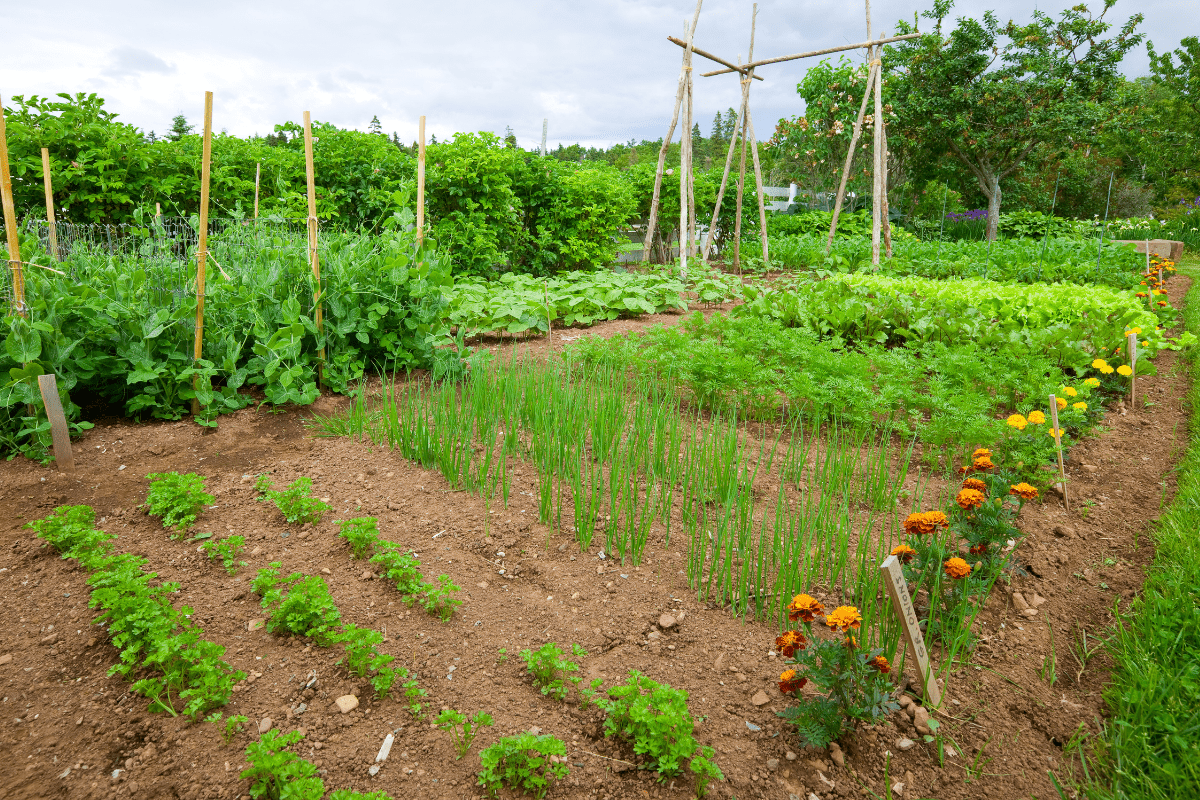Washington state produces over 300 different crops thanks to diverse microclimates divided by the Cascade Mountains, making it America's most productive agricultural region per acre. From June strawberries in the Skagit Valley to October apples in Yakima, this guide provides month-by-month calendars, storage tips, and expert advice to help you never miss peak harvest season again. The state's unique geography creates two distinct growing regions: maritime western Washington excels at berries and cool-season vegetables, while continental eastern Washington dominates in tree fruits and wine grapes.
The tale of two growing regions shapes what's on your plate
The Cascade Mountains create Washington's agricultural split personality. Western Washington's maritime climate brings 66+ inches of rain annually, fostering year-round growing of leafy greens and producing 70% of America's red raspberries. Meanwhile, eastern Washington's hot, dry summers and cold winters receive just 7-30 inches of rain but generate ideal conditions for storing apples that feed the nation… the region produces 67% of U.S. apples on 185,000 acres.
Understanding these regional differences helps shoppers anticipate what's available. In March, western Washington gardeners already harvest early spring greens while eastern Washington orchards remain dormant. By July, the pattern reverses as Yakima Valley cherries reach peak sweetness while coastal areas struggle to ripen heat-loving crops. Southwest Washington typically harvests 1-2 weeks earlier than northern areas, and every 1,000 feet of elevation delays the growing season by another 1-2 weeks.
Spring awakens asparagus spears and rhubarb stalks
March through May brings Washington's first fresh harvests after winter's stored crops. Asparagus emerges in April, with peak harvest lasting just 6-8 weeks through early June. Look for thick, uniform spears with tightly closed tips… Washington's cool springs produce exceptionally tender stalks. Rhubarb follows close behind, offering tart stalks perfect for pies and preserves.
April's warming soil triggers an explosion of spring greens. Farmers plant lettuce, spinach, and Asian greens that thrive in cool conditions. Radishes mature in just 25 days, providing the season's first root vegetable. By late May, strawberry fields turn red as Washington's berry season begins. Don't miss the first 2-3 weeks of June for peak strawberry flavor… the state's cool nights concentrate sugars in the fruit.
Spring flowers paint valleys in spectacular displays. The Skagit Valley Tulip Festival showcases 350 acres of commercial tulip production from 200+ varieties, making Washington America's top bulb producer. Daffodils bloom even earlier, starting in February, while rhododendrons, the state flower, peak from March through June depending on elevation.
Summer brings berry abundance and stone fruit sweetness
June marks the transition to summer's incredible diversity. Sweet cherries ripen from late June through July, with the prized Rainier variety commanding premium prices. Developed at WSU in 1952, Rainiers feature yellow skin with red blush and exceptionally sweet flesh. The Bing cherry dominates commercial production at 50% of the crop, but seek out Lambert and Chelan varieties for extended seasons.
July explodes with berry options as raspberries, blueberries, blackberries, and marionberries overlap in peak season. Washington leads national blueberry production at 120+ million pounds annually. The state's long summer days and cool nights create ideal growing conditions, producing berries with intense flavor and high antioxidant levels. Wild varieties like salmonberries, thimbleberries, and huckleberries reward adventurous foragers in mountain areas.
Navigate the summer vegetable learning curve
Summer vegetables reach maturity as soil temperatures climb above 55°F. Green beans, summer squash, and cucumbers flourish, though Washington's cool summers challenge heat-lovers like tomatoes and peppers. Choose early-maturing tomato varieties under 75 days and cherry types for reliable production. Walla Walla sweet onions, arriving from seeds brought in the 1880s, reach peak sweetness in July.
Here's what thrives in Washington summers:
- Cherry tomatoes beat slicers
- Armenian cucumbers handle cool nights
- Summer squash outperforms winter types
- Snap peas love maritime weather
- Herbs flourish without extreme heat
Lavender fields bloom purple across the state in July and August, with Sequim's lavender farms attracting thousands of visitors. Dahlias begin their show in August, continuing through first frost with dinner-plate varieties producing blooms over 10 inches across. Local farms grow 140+ dahlia varieties, though WSU research shows 80.9% test positive for viruses… choose certified stock for best results.
Fall delivers the apple harvest and winter squash bounty
September launches Washington's signature season as apple harvest begins with early varieties like Gala and continues through November with storage types like Granny Smith. The state grows over 30 commercial varieties, led by Red Delicious at 34% of production. The new Cosmic Crisp apple, developed by WSU from a Honeycrisp-Enterprise cross, remains exclusive to Washington growers through 2027.
Pears follow a similar pattern, with Bartlett varieties ripening in August for immediate eating while winter pears like Anjou and Bosc arrive in September for long storage. Washington produces 80% of America's pears, with most grown in the Yakima Valley and Wenatchee-Okanogan region. Unlike apples, pears ripen from inside out… harvest when firm and allow to soften at room temperature.
October brings pumpkins, winter squash, and root vegetable harvests. Brussels sprouts improve after first frost, which converts starches to sugars. Cranberries flood for harvest in Pacific County, one of the few areas nationwide suitable for commercial production. The fall harvest extends into November with stored crops providing local food through winter.
Fall flowers include asters, mums, and ornamental kale, while deciduous trees create spectacular foliage displays. Many dahlia farms remain open through October, offering u-pick opportunities until killing frost ends the season.
Winter sustains us with stored treasures and greenhouse greens
December through February challenges local eating but doesn't eliminate it. Stored apples maintain quality for 3-6 months when kept at 30-32°F with 90-95% humidity. Popular storage varieties like Fuji and Braeburn actually improve in flavor after a month of cold storage. Root cellars or unheated garages work well for potato storage at 45-50°F… never refrigerate potatoes as cold temperatures increase harmful acrylamide formation.
Winter farmers markets continue in major cities, offering storage crops alongside greenhouse-grown greens. Pike Place Market operates daily year-round, while neighborhood markets like Ballard and University District maintain weekend schedules. Look for locally grown microgreens, sprouted seeds, and mushrooms that don't require summer heat.
Planning begins for next year's garden as seed catalogs arrive. Western Washington's mild winters allow planting of fava beans and garlic in November for summer harvest. Order seed potatoes early… Skagit County produces 95% of the state's red seed potatoes, selling out popular varieties by February.
Navigate farmers markets from Pike Place to Spokane
Washington's 105 farmers markets create direct connections between growers and eaters. Pike Place Market stands as America's longest continuously operating market since 1907, hosting 70+ farmers daily alongside 220 independent businesses. Arrive before 9am for best produce selection and all-day parking at $15.
Seattle neighborhood markets follow seasonal rhythms, with Ballard's Sunday market achieving year-round status as the first neighborhood market selling exclusively Washington produce. Peak season runs May through October when markets overflow with fresh harvests. The Spokane Farmers Market operates Saturdays and Wednesdays, while Yakima Valley markets showcase the region's exceptional fruit production.
Stretch your market dollars with assistance programs
Markets accept various payment options beyond cash. SNAP users receive dollar-for-dollar matching up to $25 daily through Market Match programs, doubling purchasing power for fresh produce. WIC and Senior Farmers Market Nutrition Programs provide additional benefits… seniors receive $80 per season while WIC participants get up to $90 per household.
Shopping tips maximize market visits:
- Bring reusable bags
- Walk the entire market first
- Talk directly with farmers
- Buy seconds for preserving
- Arrive early for selection
Bring small bills, though many vendors now accept cards. Talk directly with farmers about growing practices and recipe suggestions… they're eager to share expertise. Buy in bulk for preserving projects and ask about "seconds" for canning.
Master storage techniques to prevent waste and extend seasons
Proper storage prevents the heartbreak of spoiled produce. Berries demand careful handling… refrigerate unwashed in original containers and rinse only before eating. Sort daily to remove damaged fruit that accelerates decay. For longer preservation, freeze berries individually on sheet pans before transferring to bags, maintaining texture for smoothies and baking.
Stone fruits present different challenges. Cherries last just 1-2 weeks even under optimal storage conditions, making immediate preservation essential. Remove stems and pits before freezing to save space. Peaches and nectarines continue ripening after harvest… store at room temperature until desired softness, then refrigerate to halt ripening.
Root vegetables offer winter-long storage potential when managed correctly. Potatoes require 45-50°F temperatures in dark, ventilated spaces… light exposure creates toxic green areas. Onions need drier conditions at 60-70% humidity and should never touch potatoes, which release moisture promoting sprouting. Carrots and beets store best at 32°F with 90-95% humidity, lasting months when topped and stored in damp sand.
Preserve the harvest for year-round enjoyment
Preservation extends seasons indefinitely. Water bath canning works for high-acid fruits and pickles, while pressure canning safely preserves vegetables. Altitude affects processing times… add 5-10 minutes above 3,000 feet. Dehydrating concentrates flavors, with electric dehydrators maintaining consistent temperatures better than oven methods. WSU Extension offices in Benton-Franklin and Clark counties offer Master Food Preserver programs teaching tested preservation methods.
Expert voices guide seasonal eating success
"Extension surveys show Washington residents want more fruits and vegetables but find cost prohibitive," explains Diane Smith, WSU Extension Food Access Specialist. "Farm Fresh Food Boxes provide a low-cost gateway to healthy, locally grown produce at peak freshness." The program connects families directly with farmers while building familiarity with seasonal eating patterns.
April Clayton of Red Apple Orchards brings scientific rigor to farming with her chemistry doctorate. Growing 85 acres of organic apples near Orondo, she emphasizes consumer education: "A one-on-one conversation proves more powerful than you think when discussing modern food production." Her analytical background helps interpret soil tests and optimize natural fertilizer applications.
Master Gardeners donate 44,000+ hours annually sharing research-based growing advice. Their plant clinics diagnose problems and recommend varieties suited to local microclimates. King County Master Gardeners contributed 4,252 pounds of produce to food banks in 2023, demonstrating how knowledge translates to community impact.
Benji Astrachan, WSU Extension Waste Prevention Specialist, addresses the missing middle of agriculture: "Farmers can't always sell produce wholesale due to aesthetics or minor damage. Our gleaning program recovers 1,000+ pounds weekly that would otherwise waste." His volunteers harvest semi-weekly, donating to food banks and taking home fresh produce.
Transform seasonal knowledge into delicious action
Washington's agricultural abundance stems from geographic diversity that enables year-round local eating. Mark these dates: June strawberries, July cherries and berries, September apples, October winter squash. Visit farmers markets during peak season for best selection and prices. Western Washington shoppers find year-round produce options, while eastern Washington residents should stock up during intense summer harvests.
Storage mastery prevents waste and extends enjoyment. Maintain proper temperature and humidity for each crop type. Invest in preservation skills through Extension programs… a pressure canner or dehydrator pays dividends in year-round eating. Most importantly, develop relationships with local farmers who share growing wisdom and recipe inspiration.
The path from Washington's fields to your table grows shorter when you understand seasonal rhythms. Whether selecting Cosmic Crisp apples at Pike Place Market or freezing Skagit Valley berries for winter smoothies, this guide provides the calendar knowledge and practical skills for eating Washington's best. Peak flavor awaits those who align their shopping and preservation with nature's schedule in the Evergreen State's remarkable foodshed.





